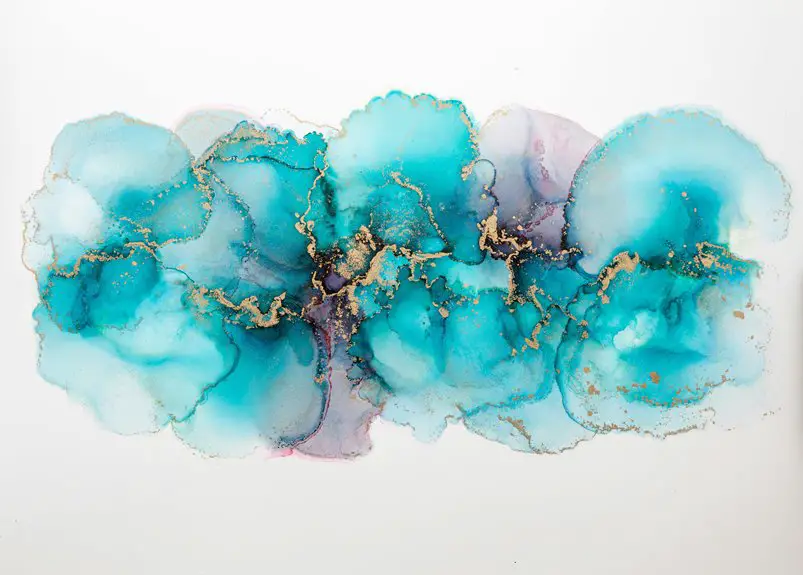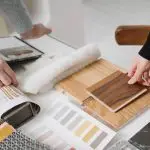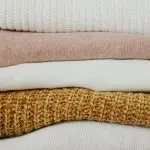To remove ink stains from upholstery, first identify the ink type—ballpoint, gel, or permanent—as each needs a different approach. Blot excess ink gently without rubbing. For ballpoint and gel ink, use rubbing alcohol or hand sanitizer on a cloth, dabbing carefully to lift stains, then rinse lightly. Permanent ink may require stronger solvents or commercial cleaners. Always test solutions on hidden fabric first. Act quickly for best results; exploring further will reveal detailed, effective methods tailored for each ink type.
Table of Contents
Key Takeaways
- Identify the ink type (ballpoint, gel, or permanent) to choose the correct cleaning method and products.
- Blot excess ink gently with a clean cloth without rubbing to avoid spreading the stain.
- Use rubbing alcohol for ballpoint and permanent ink; apply solvents like hand sanitizer for gel ink stains.
- Test any cleaning solution on a hidden upholstery spot to prevent discoloration or damage.
- Act quickly to treat stains before they set, and consider professional help for large or old ink stains.
Understanding Different Types of Ink Stains
Ink stains come in many forms, and understanding their types can help you remove them effectively. You’ll mainly encounter ballpoint, gel, and permanent ink stains on upholstery, each requiring a different approach.
Ballpoint ink is oil-based, so it tends to sit on the fabric’s surface and may smear if treated incorrectly. Gel ink is thicker and often more vibrant, making it prone to setting deeply in the fibers.
Permanent ink, as the name suggests, is designed to resist fading and washing, which makes it the toughest to remove. Knowing the ink type helps you choose the right cleaning method and products.
Identifying the stain quickly and evaluating the ink’s nature guarantees you act promptly to minimize damage and improve your chances of a successful stain removal.
Preparing Your Upholstery for Cleaning
Before you start tackling the stain, take a few simple steps to prepare your upholstery for cleaning. First, check the manufacturer’s label for any specific cleaning instructions or warnings. This helps you avoid damage.
Next, vacuum the area gently to remove dust and debris, which can interfere with stain removal. Test your chosen cleaning solution on a hidden spot to verify it won’t discolor or damage the fabric.
Blot the stain lightly with a clean cloth to absorb any excess ink without spreading it. Finally, gather all your cleaning supplies close by so you can work efficiently and avoid letting the stain sit too long.
Proper preparation sets you up for successful ink stain removal.
Removing Ballpoint Ink Stains Effectively
To tackle ballpoint ink stains, first identify the ink type to choose the right method.
Grab some rubbing alcohol and gently blot the stain—don’t rub, or you’ll spread it.
This careful approach helps lift the ink without damaging your upholstery.
Identify Ink Type
How can you tell if the stain on your upholstery comes from ballpoint ink?
Ballpoint ink usually appears dark blue or black and has a slightly greasy texture. It tends to sit on top of the fabric rather than soaking in deeply. Unlike gel or permanent ink, ballpoint ink dries quickly and is less glossy.
To identify it, look for a smooth, even stain without raised edges or smudging. You can also gently blot the stain with a white cloth; ballpoint ink will transfer slightly, unlike permanent ink, which is more stubborn.
Recognizing the type of ink is essential because each requires different removal methods. Once you confirm it’s ballpoint ink, you can proceed with targeted cleaning steps for the best results.
Use Rubbing Alcohol
Since ballpoint ink sits mostly on the surface of upholstery fabric, you can effectively break it down using rubbing alcohol. This solvent penetrates the ink, loosening it for easier removal.
Here’s how to use it properly:
- Test the rubbing alcohol on a hidden spot to ascertain it won’t damage the fabric.
- Dampen a clean white cloth with rubbing alcohol—avoid soaking it.
- Gently press the cloth onto the ink stain, allowing the alcohol to dissolve the ink.
- Repeat as needed, using a fresh cloth each time to lift the ink.
Rubbing alcohol works best on fresh stains, so act quickly.
Avoid saturating the fabric, as excessive moisture can cause damage or spread the stain.
Blot, Don’t Rub
Although it might be tempting to scrub the ink stain, you should always blot instead of rubbing. Rubbing can spread the ink deeper into the fabric fibers, making the stain worse.
Instead, gently press a clean, white cloth or paper towel onto the stain to absorb the ink. Change the cloth frequently to avoid reapplying the ink back onto the upholstery. Blotting helps lift the ink without damaging the fabric.
After blotting, you can apply a small amount of rubbing alcohol or a stain remover to the area, then continue blotting to lift the stain further.
Techniques for Gel Ink Stain Removal
When tackling gel ink stains, choosing the right solvent is key to breaking down the stubborn ink.
You’ll want to follow a clear, step-by-step cleaning process to avoid spreading the stain or damaging your upholstery.
Let’s explore which solvents work best and how to apply them effectively.
Effective Solvent Options
If you want to tackle gel ink stains effectively, choosing the right solvent is essential.
Gel ink tends to be thicker and more stubborn than ballpoint ink, so using a solvent that can break down its composition without damaging your upholstery is key.
Here are four effective solvent options to evaluate:
- Rubbing alcohol (isopropyl alcohol) – great for dissolving gel ink without harming most fabrics.
- Hand sanitizer – contains alcohol and can work similarly when applied carefully.
- Non-acetone nail polish remover – effective but test on a hidden area first to avoid discoloration.
- Commercial ink removers – specially formulated products designed for ink stains on fabrics.
Always test your chosen solvent on a small, inconspicuous spot before applying it broadly.
Step-by-Step Cleaning Process
You’ll need four basic steps to remove gel ink stains from your upholstery effectively.
First, blot the stain gently with a clean cloth to absorb excess ink—don’t rub, or you’ll spread it.
Second, apply a small amount of rubbing alcohol or a commercial ink remover onto a cotton ball or cloth. Test it on a hidden area first to avoid discoloration.
Third, dab the stain carefully, working from the outside in to prevent spreading. Keep blotting until the ink starts lifting.
Finally, rinse the area with a damp cloth to remove any residue, then let it air dry. Repeat if necessary, but always make sure you don’t saturate the fabric, or the stain might worsen or damage the upholstery.
Tackling Permanent Marker Ink on Upholstery
Removing permanent marker ink from upholstery can feel like a challenging task, but several effective methods can help you tackle the stain quickly.
Start by acting fast to prevent the ink from setting deeper into the fabric. Here’s how you can approach it:
- Blot the stain gently with a clean cloth to absorb excess ink without spreading it.
- Apply rubbing alcohol using a cotton ball, dabbing carefully to break down the ink.
- Use a commercial upholstery cleaner designed for ink stains, following the product instructions.
- Rinse with cold water and blot dry to remove any residue.
Always test any solution on a hidden area first to avoid fabric damage.
With patience and the right method, you can restore your upholstery effectively.
Using Household Items for Ink Stain Treatment
While professional products can be effective, you can often tackle ink stains using common household items you already have.
Start by blotting the stain gently with a clean cloth to soak up excess ink. Dab rubbing alcohol or hand sanitizer onto the stain using a cotton ball, then blot with a dry cloth.
For gel ink, try applying a small amount of milk or vinegar, letting it sit briefly before blotting. You can also use hairspray containing alcohol, spraying lightly and blotting immediately.
Avoid rubbing, as it can spread the stain. After treating, rinse the area with a damp cloth and let it air dry. These simple, accessible items often break down ink effectively without harsh chemicals or expensive cleaners.
Tips for Preventing Ink Stains on Upholstery
Taking care of ink stains after they happen is helpful, but preventing them in the first place saves time and hassle.
You can protect your upholstery by following these simple tips:
- Keep pens capped and stored away from seating areas to avoid accidental leaks or drops.
- Choose upholstery fabrics with stain-resistant treatments or opt for darker colors that hide minor stains.
- Establish a no-pen policy in rooms with delicate furniture, especially if children are present.
- Use slipcovers or washable throws on high-traffic furniture for an extra layer of protection.
When to Seek Professional Upholstery Cleaning
If you’ve tried home remedies without success or the ink stain covers a large area, it’s time to call in professional upholstery cleaners.
Professionals have specialized tools and cleaning agents that can tackle stubborn ink stains without damaging your fabric. You should also seek help if your upholstery is made of delicate or antique materials, as improper cleaning could cause irreversible harm.
Additionally, if the ink has set for several days, DIY methods mightn’t be effective anymore. Don’t risk spreading the stain or weakening the fabric fibers.
A professional will assess the specific type of ink and fabric, then apply the appropriate treatment safely. Remember, when in doubt, consulting an expert can save you time, effort, and costly repairs in the long run.
Frequently Asked Questions
Can Ink Stains Damage My Upholstery Fabric Permanently?
Oh, ink stains won’t just politely take a seat—they’ll crash your upholstery party permanently if you don’t act fast. You’ll regret ignoring them because those pesky marks can become stubborn, ruining your fabric’s look forever.
Are Ink Stain Removers Safe for All Upholstery Materials?
Ink stain removers aren’t always safe for all upholstery materials. You should test them on a hidden spot first to avoid damage, and choose products designed for your fabric type to keep your upholstery looking great.
How Long Should I Wait Before Treating a Fresh Ink Stain?
You should treat a fresh ink stain as soon as possible to prevent it from setting. Don’t wait—grab a clean cloth and start blotting gently right away to increase your chances of successful removal.
Will Repeated Cleaning Affect the Color of My Upholstery?
Yes, repeated cleaning can fade your upholstery’s color or damage the fabric. You should test any cleaner on a hidden spot first and avoid harsh scrubbing to keep your fabric looking fresh and vibrant.
Can I Use a Steam Cleaner to Remove Ink Stains?
You can use a steam cleaner cautiously, but be aware it might set the ink stain further. Test a hidden spot first, and combine steam cleaning with appropriate stain removers for better results without damaging your upholstery.
- Nonwoven Fabric vs. Paper: A Comparison of Properties - July 11, 2025
- The Role of Nonwoven Fabrics in Filtration Systems - July 11, 2025
- Can You Recycle Nonwoven Polypropylene Bags? - July 11, 2025







